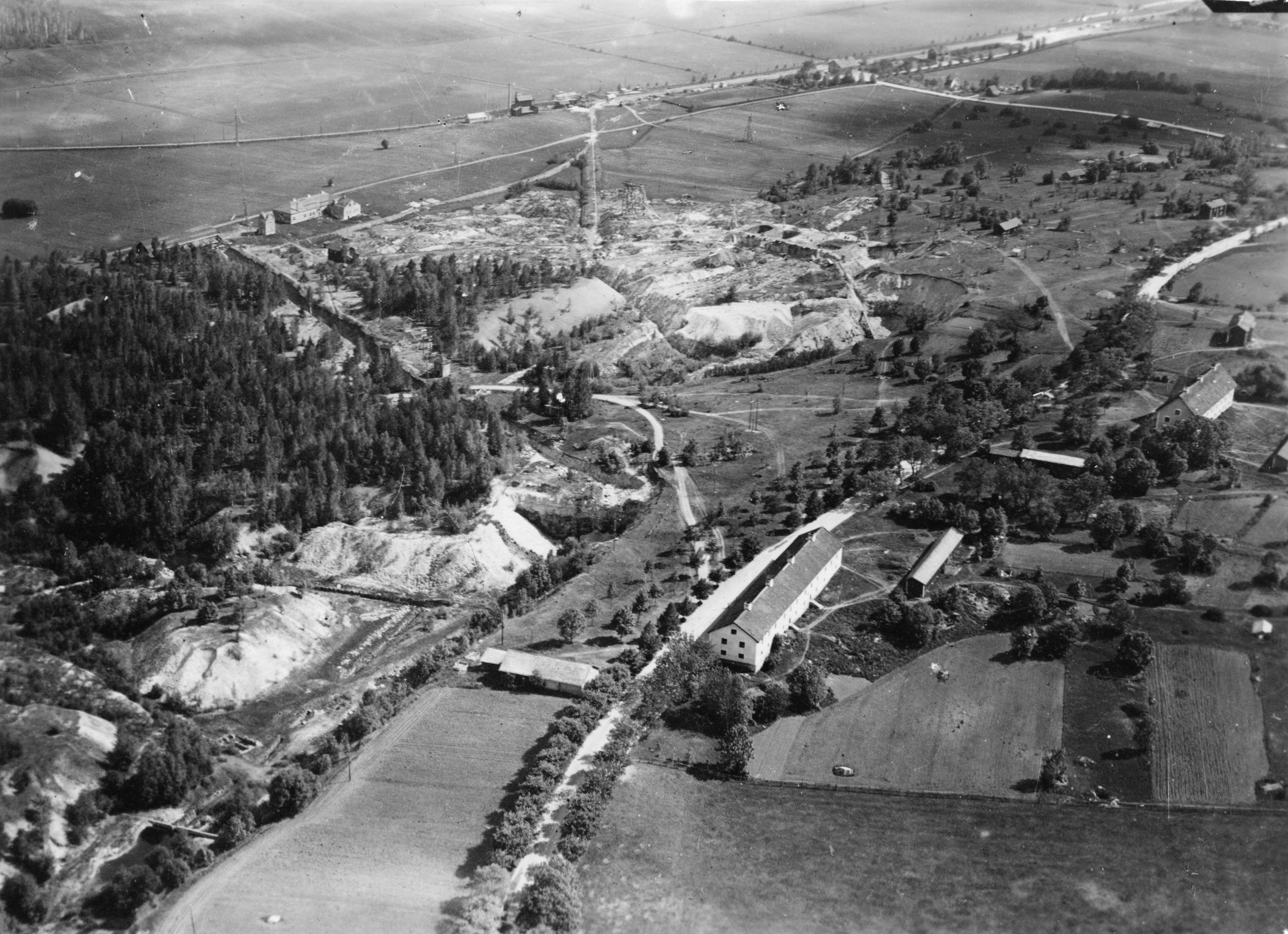Mining of Alum Shale is not a new idea at all. Alum Shale has been mined for centuries in Sweden and today we are left with huge heavy metal (and Uranium) leaking piles of mining waste.
Initially the Alum Shale was mined for Alum. Alum has been used since ancient times for a variety of applications: for example for dyeing and tanning, for cosmetics and food preparation, for stemming bleeding when shaving, water treatment, and so on.
The first place, where alum was mined in Sweden was in Andrarum in Österlen. The mine opened in 1637 and was more or less continuously active until 1906. Visitors can today look at what is left from this huge mine, but they will probably not notice how weathering of the broken shale leads to release of heavy metals and uranium and how these are transported by the small stream Verkeån into the Baltic Sea.

Downloaded from https://sv.wikipedia.org/wiki/Andrarums_alunbruk#/media/Fil:Andrarums_alunbruk_1.jpg Av Jorchr – Eget arbete, CC BY 3.0, Länk
The mine at Andrarum was also active between 1942 and 1945. During these years mining focused on Vanadium.
The next Alum Shale mine opened in Degerhamn on Öland in 1723 and was active until 1890. Today a huge deposit (2.6 million cubic meters on an area of 63 hectare) with burnt Alum Shale (red ash) remains and leaks directly into the Baltic Sea. A news article from 2005 states: “The red ash contains numerous pollutants and most dangerous for humans is arsenic. The red ash at Degerhamn forms a risk for humans and nature and the county government therefore commissioned an investigation. Numerous samples have been analysed for poisonous substances and to understand how much may leak out and how dangerous the red ash is for inhabitants and tourists. The red ash contains high amounts of uranium, cadmium, barium, vanadium and molybdenum, but it is arsenic that is most dangerous. Small children, who happen to put soil or red ash in their mouths risk poisoning and even skin contact with red ash can be dangerous. Should someone grow something on the land, then the vegetables can be dangerous to eat.” (my free translation). This newspaper article sounds really alarming. But probably people have forgotten most of this by now. After all it has been published 14 years ago ….
A few decades after the mine at Degerhamn opened, mining of Alum Shale started in Latorp in Närke (1765-1869) and even today the huge red ash deposits are still present.

https://digitaltmuseum.se/021016320294/alunbruket-i-latorp
Later on, the Alum Shale became very interesting as a gas and oil reservoir and mines opened, among others in Fornåsa in Östergötland, Kinnekulle in Västergötland (1909-1915) and Kvarntorp in Närke (1942-1966).
The mine at Kinnekulle in Västergötland, produced up to 500 ton of oil per year by heating up Alum Shale. Today, the area is part of a Geopark and discussions were still ongoing last year whether the mine could be opened as a tourist attraction.
Oil and Uranium were extracted from the Alum Shale in Kvarntorp. About 100 000 cubic meter of oil were obtained annually and the remaining shale waste, which contains some oil is still burning and now forms a huge smoking hill. Temperatures in the hill attain up to 700 degrees C. The whole mine waste deposit is 110 m high and contains 40 million cubic meters of shale on an area of 50 hectare.
Bert Allard from Örebro University has calculated the value of some of the metals that are contained in this huge waste deposit. He assumes that the Kvarntorp hill is made up of about 25-50 million ton shale and that the shale contains >10 000 ton Vanadium (= 60-280 SEK/ton shale), >4000 ton rare earth metals (=50-150 SEK/ton shale), >4000 ton molybdenum (= 25-65 SEK/ton shale), >4000 ton uranium (=15-90 SEK/ton shale), >0.5 ton platina and palladium (=7-10 SEK/ton shale), >4000 ton Nickel (4-40 SEK/ton shale), >0.2 ton gold, >5000 ton copper, >2500 ton chromium, >7500 ton zinc. Taken together, this means that the waste has a value of between 160 and 635 SEK/ton shale or in other words: this smoking hill hosts between 5 and 18 billion Swedish kronor!
Maybe it would be a so much better idea to first exploit the mining waste that is already there and which is continuously leaking heavy metals to the groundwater, instead of loudly advertising that new mines will save our climate and our planet! I would rather say that we could save both the climate and the planet and the inhabitants by first taking care of the polluting waste!
I forgot to mention another short-lived mine, the one in Ranstad in Västergötland, where uranium was extracted from the Alum Shale between 1965 and 1969 and where we now can look at 1.5 million ton of waste deposits on an area of 25 hectare.
I visited Västergötland for the second time in 1990 (first time was 1976) and participated in an excursion along the Middle Swedish endmoraine zone. What I most vividly remember from this excursion is the visit to an abandoned mine close to Ranstad. One of the excursion guides carried a Geiger counter with him and told us that we should absolutely not stay for too long at this specific place! Maybe the precautions were made having the recent Chernobyl catastrophe in mind? Maybe the guide was too careful? I don’t have an answer.


Pingback: Leakage | Barbara Wohlfarth